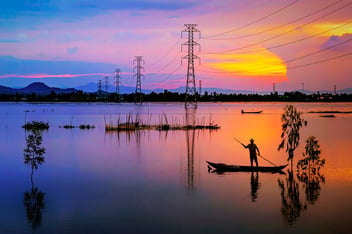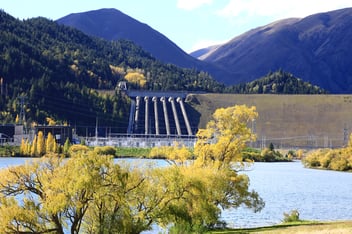How clean power can transform the "food-energy-environment trilemma"
Water scarcity has always been a concern in Australia, particularly with regards to balancing uses across industrial, mining, food, feed and fibre production, and household uses along with maintaining sufficient environmental flows, but this could change dramatically with the availability of abundant, clean energy.
As part of the Water Source’s expert series, CSIRO Land & Water Science Director Dr Paul Bertsch discusses the food-energy-water nexus, and how transitioning to clean energy will transform the way we produce food and how we think about water security.
It’s impossible to consider water security without taking account of food, feed, fibre production and energy, as they are inextricably linked. This three-way interdependence has been termed the food-energy-water nexus.
This nexus has also been referred to as the food-energy-environment trilemma, as our current agriculture, food and energy systems have had profound impacts on the environment more broadly than just water (Tillman et al., 2009).
For example, humans have transformed about 50% of Earth’s ice-free land area and most of this has been for food, feed and fibre production. This vast alteration of land use has disrupted ecosystem function, driven the sixth mass extinction of species that we are currently experiencing, and been responsible for greater than 30% of all post-industrial revolution anthropogenic greenhouse gas (GHG) emissions.
Additionally, our current fossil fuel dominated energy system is largely responsible for climate change, the global atmospheric dispersion of contaminants, such as mercury, and is responsible for millions of human deaths per year as a result of degraded air quality. In Australia alone, coal fired power plants are responsible for an estimated 800 premature deaths, 1400 asthma attacks and 845 cases of low birth rates of newborns annually (Farrow et al., 2020).
The challenge with agriculture
Agriculture is very energy intensive and responsible for about a third of all GHG emissions annually. In addition to GHG emissions resulting from land use change, other emissions come from fossil fuel intensive activities that include fertiliser production and the operation of heavy equipment, such as tractors and harvesters, transportation, as well as nitrous oxide and methane releases from plant food and feed production systems and raising animals for meat and dairy products.
Agriculture is also very water intensive, with about 70% of the earth’s freshwater being used in our food, feed and fibre production systems. Thus, our current food, feed, and fibre production systems are driving significant environmental degradation, such as biodiversity loss, and pollution from phosphorus, nitrogen, and pesticides that leak from our agricultural systems into waterways.
Transforming food production
Transforming our food production system is integral to meeting the environmental challenges we now face while also meeting the significant increase in food demand to feed the 9.5 billion people expected on the planet by mid-century, with a 70% increase in food production required.
This transformation in food production systems will involve moving away from traditional sources of protein, which are primarily animal proteins, towards either plant-based proteins or, even more exciting, protein produced via precision fermentation. Plant proteins used in alternate meats are currently separated from peas, chickpeas and fava beans, utilising 75% less water per kilogram of meat alternative compared to a kilogram of beef (Fresán et al., 2019).
Precision fermentation involves using synthetic biology techniques to engineer single-celled organisms to produce proteins that can be made into food products, in much the same way yeast has been used to produce beer and wine (Lv et al, 2021).
There currently are companies producing milk proteins through this process and then formulating these with plant-based lipids to manufacture vegan milk, ice cream, and cheese. Other companies are focused on fermenting proteins having the meat-like flavours and textures of the proteins currently extracted from lupines, so that plants will no longer have to be grown to provide these alternate proteins.
So the water and environmental footprint would be lowered significantly even below plant-based meats and given the fermentation tanks are in a very controlled environment, the production would be protected from climate impacts.
This transition is happening much more rapidly than what was predicted even three or five years ago, where the general belief was that these alternate proteins would constitute only a marginal percentage of food proteins consumed globally.
The rapid consumer acceptance and diversity of alternate protein foods in the last few years has demonstrated a much more aggressive growth trajectory, with estimates that alternate protein foods will constitute as much as 22% of all protein consumed globally by 2035 (Witte, et al., 2021).
There have also been significant advances in the production of meats from stem cells and the advances in production and gene editing continues to drive the costs down. One report suggests that 35% of all meats will be cultured meat by 2040 (AT Kearney, 2019). Rapid growth in alternate protein-based foods as well as in cultured meats will greatly reduce the environmental footprint of food production and free up land for afforestation and ecosystem restoration at scale, which has been identified as a critical action to slow global warming and maintain global temperature increases to 2oC (IPCC, 2021).
The other major transition occurring in food production is moving it indoors into controlled environmental conditions, known as controlled environmental agriculture (CEA) (Benke and Tomkins, 2017; Sarathkumar et al., 2020).
Vertical agriculture is a typical and transformational CEA approach to food production from plants that utilises LED lighting, total environmental control, sensor and sensor technology, big data/data analytics fueled by artificial intelligence and machine learning, and robotics to optimise plant growth and crop yields.
Indoor agriculture uses between 80-95% less water, reduces or eliminates pesticide use, minimises the leakage of nutrients to the environment, results in a 99% decrease in land use for a similar yield, and can greatly reduce the transportation of foods (Stein, 2021). Just as with precision fermentation, CEA is climate proof.
The investment and projected growth in vertical agriculture also far exceeds expectations and this has been accelerated even more by the current pandemic (Mordor Intelligence, 2020; The Food Institute, 2020).
While the current economic challenges to upfront infrastructure and energy costs have led the emerging industry to focus on high value fruits and vegetables, a recent study demonstrates that even wheat production would be several hundreds-of-times higher per ha when produced in vertical CEA, with all of the accompanying environmental benefits outlined above (Asseng et al, 2020).
The largest obstacle for CEA to totally disrupt traditional agriculture is the relatively high cost of energy and access to readily available renewable energy from wind, solar, and green hydrogen and other zero emission energy sources, such as advanced nuclear technologies and small modular reactors (SMRs).
The green energy transition: reimagining the nexus and solving the trilemma
To transform our food production system and reap the environmental and climate benefits will require a transformation of our energy system. Creating more affordable zero-emissions energy sources will drive the cost of electricity down and make these new food production systems economically feasible, especially when factoring in the carbon and biodiversity credits that will accompany this transition.
Furthermore, transforming the energy system enables desalination and distribution of fresh water at scale, solving the food-energy-environment trilemma and virtually eliminating water security challenges.
Pipelines have been used to transport water long distances for millennia and pipelines for oil and gas were first used in the 1860’s with transcontinental pipelines for oil and gas becoming common over the past 70 years. As the value of oil and gas continues to decrease and the value of water increases over time, pipelines for moving fresh water great distances to provide water security will become increasingly attractive.
Water security has understandably been a front and centre challenge because we live on one of the driest continents on earth and because of the disruption of food production and scarcity of fresh water for communities and the environment due to cyclical intense droughts that are being intensified by climate change.
However, climate change does not influence the water balance, it intensifies the water cycle, causing more frequent and intense droughts and episodic floods. The transformation of our energy system from fossil fuels to low/zero emissions renewable and advanced nuclear energy SMRs will totally disrupt how we think about water security in the future.
The ability to desalinate water at scale affordably and with very low or zero carbon emissions means there will be ready access to currently undeveloped fresh water supplies. Thus, the grand global challenge surrounds the scaling of renewables and advanced nuclear SMRs on an aggressive timescale.
The energy transformation will be driven by countries having to respond to climate change and the need for rapid action to reduce emissions and enhance carbon sequestration.
Implementation of policy levers will likely extend far beyond a sovereign country’s borders. For example, Europe has already signaled future import rules based on the footprint of goods for trading partners based on their climate policies, energy mix, and full life-cycle analysis of products.
The nexus concept suggests that solving the food, energy, environment trilemma is an energy challenge that, when addressed, will provide a secure and climate proof supply of food and water along with immense environmental, social and economic benefits.
References
Asseng, et al., 2020. Wheat yield potential in controlled-environment vertical farms. PNAS 117:19131-19135.
AT Kearney, 2019. When consumers go vegan, how much meat will be left on the table for agribusiness?
Benke and Tomkins, 2017. Future food production systems:vertical farming and controlled-environment agriculture. Sustainability:Science, Practice and Policy. 17:13-26
Farrow, et al., 2020. Lethal Power: How coal is killing people in Australia. Greenpeace Australia Pacific Greenpeace Australia Pacific. 41pp
Fresán et al., 2019. Meat analogs from different protein sources: Comparison of their sustainability and nutritional content. Sustainability 11:3231-3241
IPPC, 2021. https://www.ipcc.ch/assessment-report/ar6/
Lv et al, 2021. Synthetic biology for future food: Research progress and future directions. Future Foods 3:100025 https://doi.org/10.1016/j.fufo.2021.100025
Mordor Intelligence, 2020. VERTICAL FARMING MARKET - GROWTH, TRENDS, COVID-19 IMPACT, AND FORECASTS (2021-2026) https://www.mordorintelligence.com/industry-reports/vertical-farming-market
SarathKumar et al., 2020. Vertical farming: Moving from genetic to environmental modification. Trends in Plant Science 25:724-727
The Food Institute, 2020. Vertical farming accelerated by Coronavirus. https://foodinstitute.com/focus/vertical-farming/
Tillman et al., 2009. The Food, Energy, and Environment Trilemma. Science 325:270


